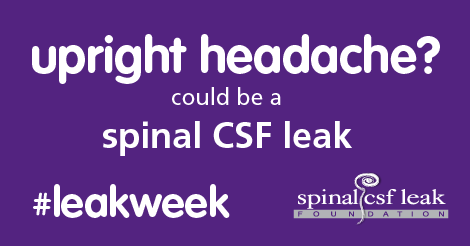Today is DAY 7 of Spinal CSF Leak Awareness Week.
Our focus for our last day of Leak Week is: Prognosis of spinal cerebrospinal fluid (CSF) leak
and Looking Forward.
Prognosis
While published patient outcomes remain rather limited, we do know that most patients do well.
More publications reporting on short-term and long-term outcomes are anticipated.
Following successful treatment, Rebound Intracranial Hypertension (elevated CSF pressure), may occur following treatment. This usually presents with a different pattern of headache in location, quality and positional aspect, but is not always readily distinguished from the headache associated with intracranial hypotension (low volume of CSF in the brain). Associated symptoms may be similar or dissimilar from pre-treatment. Because research on this has been limited to date, understanding of the best treatment approaches remains limited. Acetazolamide is the medication prescribed most often, but several other medications are also in use.
Please visit our information page on Prognosis.
Looking Forward
Raising awareness has been the major focus of this inaugural #leakweek.
With our new video animation, we introduced the tagline “Upright headache could be a spinal CSF leak” to help patients that may be suffering to have this diagnosis considered. While a cure remains elusive for some, it is the outcome for many, providing that the correct diagnosis is made and appropriate treatment is accessible.
The challenges:
– low awareness among health care professional contributes to underdiagnosis (misdiagnosis, delayed diagnosis)
– the range of symptoms and manifestations is broad which contributes to delayed diagnosis
– few centers with expertise limits timely access to appropriate care
– diagnostic imaging requires experience and expertise to optimize performance and interpretation
– spinal imaging remains inadequately sensitive to localize a large percentage of leaks which impacts treatment options
– at times, insurance coverage is limited or denied for testing and treatment due to low awareness by health insurers
– while many patients do very well, some patients do continue to suffer with variable severity of symptoms and associated disability.
– research to better understand many aspects of this disorder remains limited
The good news:
– unlike many rare or rarely-diagnosed disorders, spinal CSF leak has an underlying anatomic cause (a hole or tear in the dura around the spinal cord) that can heal spontaneously or respond to available treatments
– many patients can be cured or at least have an improved quality of life with treatment
– more health care professionals are now aware of spinal CSF leak and are interested in learning more
– centers with more experience are collaborating to advance the care and outcomes for patients
– the pace of new publications has been accelerating
Intracranial Hypotension Symposium
This is being hosted by Cedars-Sinai Medical Center in partnership with Spinal CSF Leak Foundation.
There will be two tracks: a professional track and a patient / caregiver track.
The full agenda will be available next week when registration opens.
We will post an update accordingly.
We do hope to see you there!
Thank you for participating in #leakweek and assisting in raising awareness.
Your donation can help to accelerate changes in the “good news” category:
– more awareness for faster diagnosis
– more education, such as the upcoming Symposium, for both health care professionals and patients
– better access to skilled health care professionals
– more research for a better understanding of all aspects of spinal CSF leak to improve outcomes
– more patients with optimal outcomes
Here are a few links to let you review some highlights from #leakweek 2017.
- Our new animated video called Upright Headache – my spinal CSF leak was released on Day 1.
- The National Organization of Rare Disorders (NORD) released a new Rare Disease Database Report on spontaneous intracranial hypotension, also known as spontaneous spinal cerebrospinal fluid (CSF) leak in advance of Leak Week.
- Landmarks across North America shone purple for #leakweek – see the photos from all week on Facebook and Twitter.
We will be posting many of the photos on our Leak Week 2017 page as well during the next week.
Also check out the locations that will be lit purple tonight:
Rundel Memorial Building – Rochester, NY
Vancouver Convention Centre – Vancouver, BC - Pennsylvania Senate passed a resolution to recognize Spinal CSF Leak Awareness Week 2017.
- Replay the 3 Expert Q & A sessions that were held on March 1 – 3, 2017.
- Download our updated resource documents.


